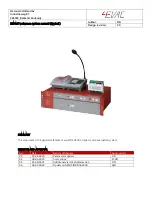
42
Chemical compatibility of wetted materials
AZURA® Conductivity Monitor CM 2.1S Instructions, V6710
Zirconium oxide (Z
r
O
2
)
Zirconia ceramics are characterized by their high mechanical resistance,
which makes them particularly resistant to wear and corrosion. It is also
biocompatible, has low thermal conductivity and is resistant to high
pressures.
Sapphire
Synthetic sapphire is virtually pure monocrystalline alumina. It is biocom-
patible and very resistant to corrosion and wear. The material is character-
ized by a high hardness and a high thermal conductivity.
Ruby
Synthetic ruby is monocrystalline alumina and gets its red color by the
addition of some chromium oxide. It is biocompatible and very resistant
to corrosion and wear. The material is characterized by a high hardness
and a high thermal conductivity.
Mineral wool
This insulating material consists of glass or stone wool fibres and isolates
in high oxidizing conditions and at high temperatures. Mineral wool is
valid as commonly inert against organic solvents and acids.
Glass, glass fibre, quartz, quartz glass
These mineral materials are resistant against corrosion and wear and are
mostly chemical inert. They are compatible with oils, fats and solvents and
show a high resistance against acids anf lyes up to pH values of 3-9. Con-
centrated acids (especially hydrofluoric acid) may embrittle and corrode
the minerals. Lyes may ablate the surfaces slowly.
12.4 Metals
Stainless steel
Stainless steel is, apart from PEEK, the standard material in HPLC.
Steels with WNr. 1.4404 (316L) are used, or with a mixture of higher
compatibility.
They are inert against almost all solvents. Exceptions are biological appli-
cations which are metal ion sensible, and applications with extreme cor-
rosive conditions. These steels, in comparison to commonly used steels,
are increasingly resistant against hydrochloric acid, cyanides and other
halogen acids, chlorides and chlorinated solvents.
The use in ion chromatography is not recommended. In case of electro-
chemical applications, a passivation must be executed first.
Hastelloy®-C
This nickel-chrome-molybdenum alloy is extremely resistant to corrosion,
especially against oxidizing, reducing and mixed solvents, even at high
temperatures. This alloy may be used in combination with chlor, formic
acid, acetic acid and saline solutions.



































